Street food in South Korea
[2] In the Joseon period street vendors began to form a base of economic activity in the low-income bracket around markets.
After the Korean War street vendors prospered by serving refugees and the large numbers of U.S. troops.
[3] After the Korean War, street food vendors made a huge impact on people who had a lower standard of living by providing them with affordable meals.
These traditional snacks could easily be called ‘the ancestors of Korean street food’, since they were passed down to Korea from Japan during the early 1900s.
A third issue relates to selling by squatters, usually elderly people, in subway stations, where it is illegal.
Street foods are intended to be visually appealing as well as delicious, and the preparation can be an entertainment in itself, for example watching a vendor's hands as they roast the ingredients on an iron plate.
[1] The number of pojangmacha in Seoul has recently declined, due to people claiming the establishments are unsanitary and illegal, since many vendors operate without permits (Deborah 2018).
You can taste fusion rice ball with Japanese pork and kimchi, Vietnamese deep-fried dumplings, mie goreng which means Indonesian fried noodles, and so on.
Recently Noryanjing has become popular with tourists after publicity on social media started by international students.
[15] Some food markets stay open late for those grabbing a bite from a long night but the more common one's usually tend to close either at 6pm or 11pm.
The Food Alley has a variety of Korean dishes to offer such as steamed corn, dakkochi (chicken skewers) jokbal (pigs’ feet) and more.
Additional things besides foods are in Namdemun Market where, Whether you're looking for jewelry, luggage, stationery, hiking gear, camera parts, or traditional handicrafts, you're sure to find what you seek, and at an affordable price.




